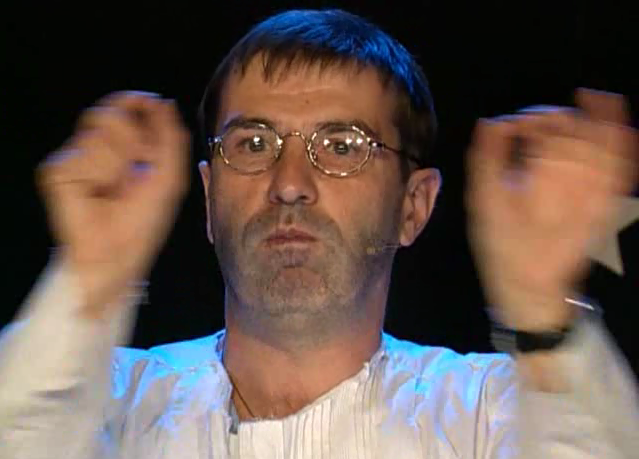Where does the current flow or where is this damned cathode?
There are things that you want what is called "razvidet" - the term is quite well-established and understandable.

- Evgeny Grishkovets, tells about railway workers. (c) Performance “Simultaneously”
And there are things that, well, can not remember. This arises from the fact that a new concept cannot unambiguously cling to already known facts in consciousness, and it does not work to build a new connection in the semantic network of facts.
Everyone knows that the diode has a cathode and an anode. Everyone knows how a diode is indicated on an electrical circuit. But not everyone can correctly say where on the diagram that.
Under the spoiler picture, looking at that, you will always remember where the diode anode, and where the cathode. I must warn you, it will not work out, so that those who are not confident in themselves should not open it.
The current is the directional motion of charged particles — we all know this from school physics. What kind of particles? Yes, any charged! It can be electrons carrying a negative charge and particles deprived of electrons — atoms or molecules, ions in solutions and plasma, “free electrons” or “holes” in semiconductors, whatever that means. So, in all of this zoo the easiest way to understand this: the current flows from plus to minus, that's all. It is very easy to remember: “plus” - intuitively - this is where something is “more”, more charges in this case (again, no matter what!) And they flow in the direction of “minus”, where they are few and waiting. All other details are unprincipled.
Well, and the last - the battery. The designation is also known to all, the two sticks are genuinely thinner and shorter than the thicker one. So shorter and thicker symbolizes a minus - a kind of "fat minus" - like in school, remember: "I give you four with a fat minus ." I just remembered, maybe someone will offer a better option.
Now, you can easily answer the question of whether the light bulb lights up in this circuit:

All from April 1! Smile, gentlemen. Smile!
- Evgeny Grishkovets, tells about railway workers. (c) Performance “Simultaneously”
And there are things that, well, can not remember. This arises from the fact that a new concept cannot unambiguously cling to already known facts in consciousness, and it does not work to build a new connection in the semantic network of facts.
Everyone knows that the diode has a cathode and an anode. Everyone knows how a diode is indicated on an electrical circuit. But not everyone can correctly say where on the diagram that.
Under the spoiler picture, looking at that, you will always remember where the diode anode, and where the cathode. I must warn you, it will not work out, so that those who are not confident in themselves should not open it.
Now that we have scared away the weak, we continue ...
Yes, that's how simple it is. The letter K is the cathode, the letter A is the anode. Sorry, now you will never forget it.
')
Continue and see where the current flows. If you look closely, the designation of the diode is an arrow. Here, do not believe it - the current flows exactly where the arrow shows! Which is logical, isn't it? Further more - the current flows " And then" (from the Anode) and " To Ud" (to the Cathode). In the notation of the transistors, too, there are arrows, and they also indicate the direction of the current.

Yes, that's how simple it is. The letter K is the cathode, the letter A is the anode. Sorry, now you will never forget it.
')
Continue and see where the current flows. If you look closely, the designation of the diode is an arrow. Here, do not believe it - the current flows exactly where the arrow shows! Which is logical, isn't it? Further more - the current flows " And then" (from the Anode) and " To Ud" (to the Cathode). In the notation of the transistors, too, there are arrows, and they also indicate the direction of the current.
The current is the directional motion of charged particles — we all know this from school physics. What kind of particles? Yes, any charged! It can be electrons carrying a negative charge and particles deprived of electrons — atoms or molecules, ions in solutions and plasma, “free electrons” or “holes” in semiconductors, whatever that means. So, in all of this zoo the easiest way to understand this: the current flows from plus to minus, that's all. It is very easy to remember: “plus” - intuitively - this is where something is “more”, more charges in this case (again, no matter what!) And they flow in the direction of “minus”, where they are few and waiting. All other details are unprincipled.
Well, and the last - the battery. The designation is also known to all, the two sticks are genuinely thinner and shorter than the thicker one. So shorter and thicker symbolizes a minus - a kind of "fat minus" - like in school, remember: "I give you four with a fat minus ." I just remembered, maybe someone will offer a better option.
Now, you can easily answer the question of whether the light bulb lights up in this circuit:

All from April 1! Smile, gentlemen. Smile!
Source: https://habr.com/ru/post/392487/
All Articles